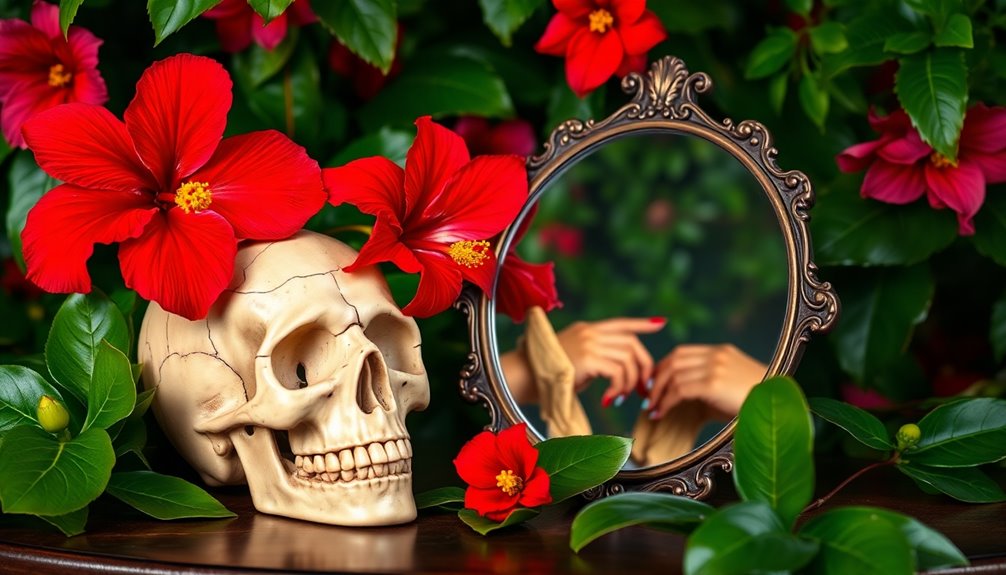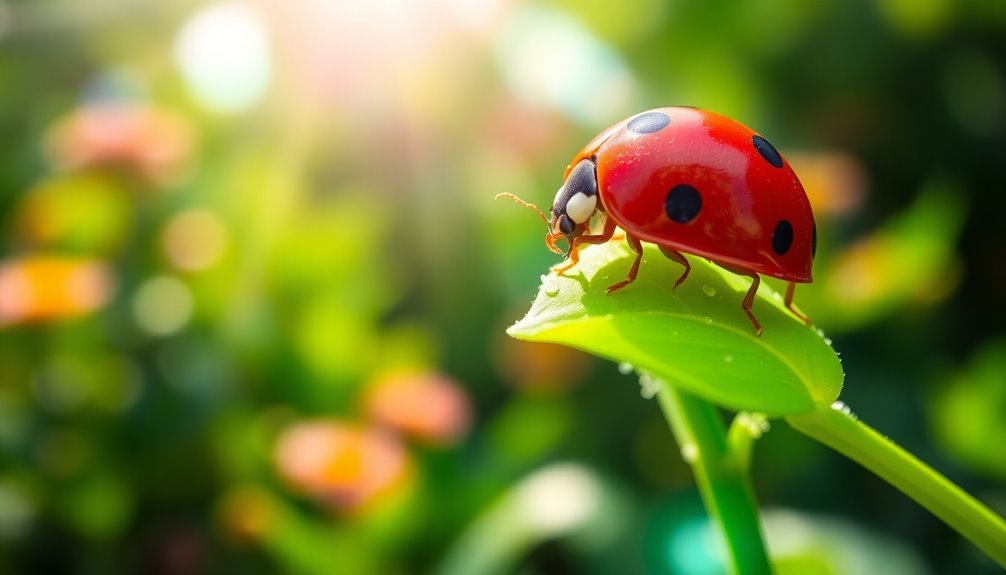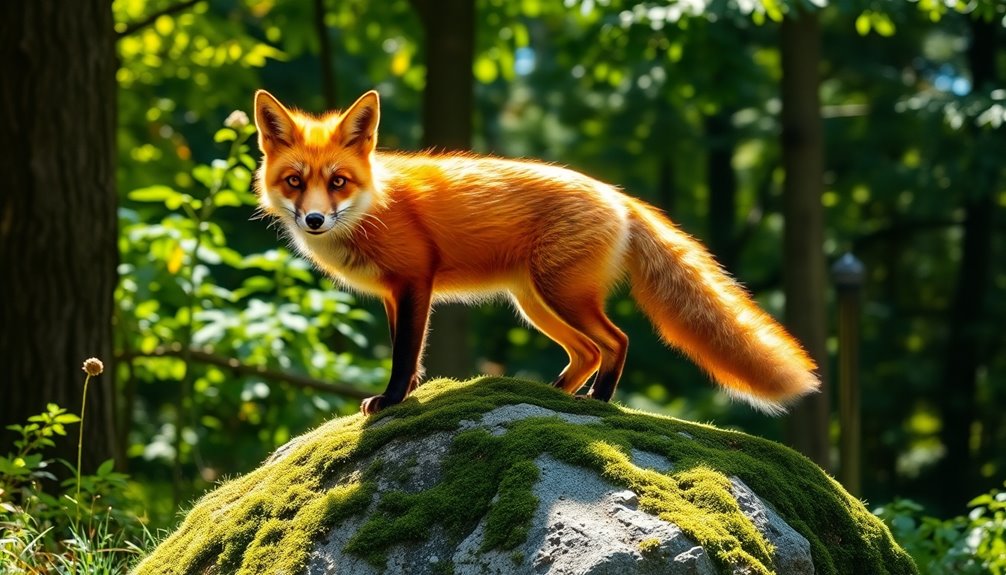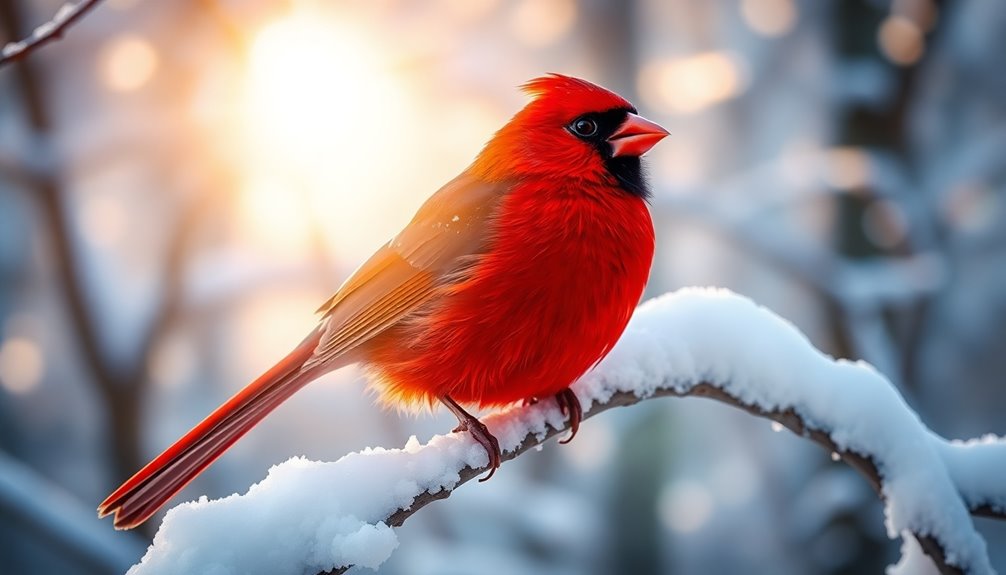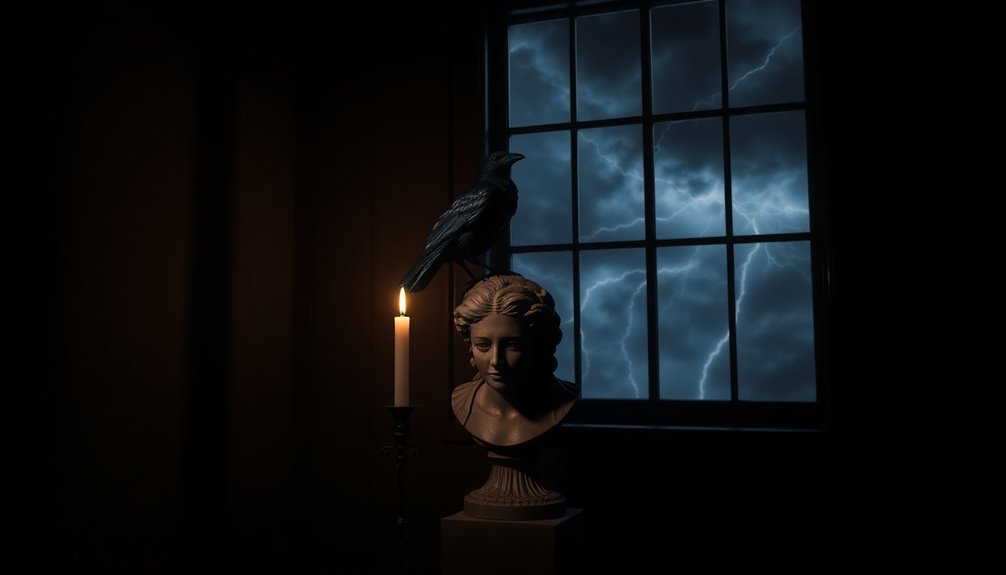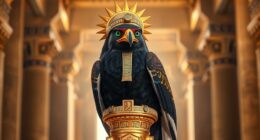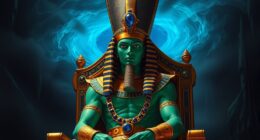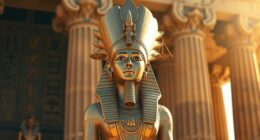Frida Kahlo used symbolism in her artwork to express her identity, emotional pain, and resilience. Through over 50 self-portraits, she highlighted themes like suffering and cultural heritage. For instance, her Tehuana headdress represents her Mexican roots, while thorns in "Self-Portrait with Thorn Necklace" symbolize endurance amidst agony. Kahlo's use of vibrant colors also reflects her mixed cultural identity and complex emotions. She infused her art with political commentary, framing her personal struggles within a broader social context. If you explore further, you'll uncover more about how her symbols reflect her life and legacy.
Key Takeaways
- Kahlo employed rich symbolism, such as the Tehuana headdress, to express her Mexican heritage and cultural identity.
- Thorns and broken columns in her art represent emotional pain and resilience, reflecting her personal struggles.
- Animals in her paintings, like hummingbirds and black cats, symbolize contrasting emotions and complex relationships.
- Bright colors and traditional symbols highlight her cultural authenticity while conveying deeper emotional narratives.
- Works like "The Two Fridas" illustrate duality in identity, using symbolism to explore vulnerability and strength.
Frida Kahlo's Self-Portraits
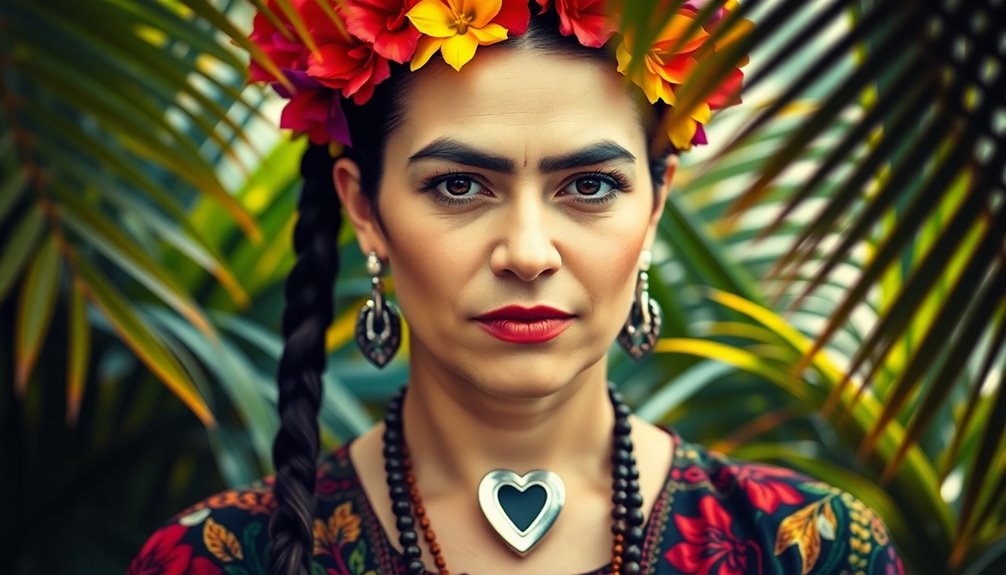
Frida Kahlo's self-portraits serve as a powerful lens into her complex inner world. With over 50 self-portraits, she used this medium to explore her identity, emotional pain, and femininity.
Kahlo incorporated rich symbolism into her work, often featuring elements like the Tehuana headdress, signifying her deep pride in her Mexican heritage. This connection to her roots not only celebrates her cultural identity but also highlights the importance of personal history in shaping one's self-image.
In pieces like "Self-Portrait with Cropped Hair," you see her bold rejection of traditional gender roles and societal expectations of femininity. This act of cutting her hair becomes a potent symbol of defiance and self-assertion.
Meanwhile, works such as "Self-Portrait on the Borderline" reveal her cultural duality, blending introspection with reflections on her mixed heritage.
Through these self-portraits, Kahlo articulates a complex narrative that resonates with modern audiences, showcasing themes of resilience and emotional complexity. Her ability to intertwine personal experience with broader cultural symbols offers you a profound insight into the struggles and triumphs of her life.
Themes of Pain and Emotion
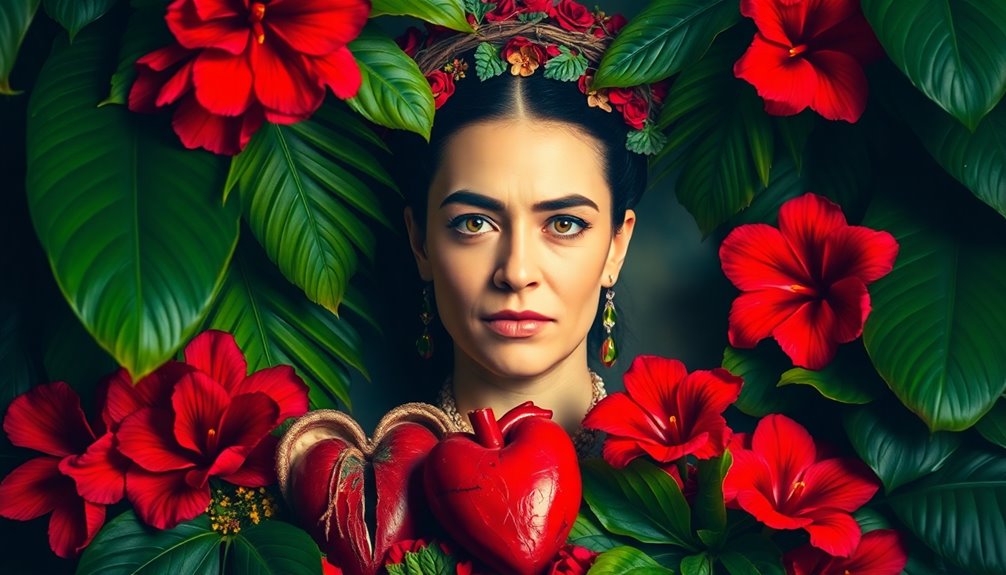
Frida Kahlo's art vividly captures the essence of her physical pain and emotional turmoil, inviting you to experience her struggles.
You'll notice how she uses symbols like broken columns and thorns to represent her suffering and resilience.
Through her work, she not only shares her scars but also highlights a profound connection between pain and identity.
Representing Physical Pain
Kahlo's artwork serves as a visceral exploration of physical pain, drawing viewers into her world of suffering and resilience. Through her self-portraits, she vividly symbolizes her chronic pain and emotional turmoil, providing insight into her personal experiences.
In "Self-Portrait with Thorn Necklace and Hummingbird," the thorn necklace becomes a poignant symbol of her suffering, illustrating the deep connection between her physical and emotional states.
In "The Broken Column," she starkly represents her spine as a broken column, emphasizing her vulnerabilities and the relentless nature of her pain. The wounded deer in "The Little Deer" echoes her fragility, mirroring her inner struggles and traumas.
Kahlo's use of blood and wounds in her self-portraits serves as powerful symbols of her ongoing suffering, revealing how closely intertwined her physical pain is with her identity.
Emotional Turmoil Explored
Art provides a powerful lens through which to examine emotional turmoil, and Kahlo's work is no exception. Her self-portraits are rich in symbolism, allowing you to explore her profound pain and suffering. In "Self-Portrait with Thorn Necklace and Hummingbird," the thorn necklace represents her enduring emotional agony, while the hummingbird offers a glimmer of hope amid despair.
In "The Broken Column," Kahlo uses a column to embody her chronic pain, visually depicting her vulnerability. The animals in her art further enrich this emotional landscape; for instance, the black cat signifies bad luck, contrasting with the hope symbolized by the hummingbird.
In "The Little Deer," Kahlo depicts herself as a wounded deer, a poignant representation of her feelings of martyrdom and suffering. Through these symbolic elements, such as butterflies and flowers, she explores themes of resurrection and rebirth, reflecting her complex emotional state.
Kahlo's ability to channel her emotional turmoil into her art not only highlights her pain but also showcases her resilience in the face of such profound struggles.
Resilience Through Suffering
Through her vivid imagery, Frida Kahlo captures the essence of resilience born from suffering, inviting you to witness the depth of her emotional experience. Her self-portraits reveal a profound exploration of pain, with symbols like the thorn necklace in "Self-Portrait with Thorn Necklace and Hummingbird" representing enduring suffering while simultaneously illustrating her strength. The hummingbird, a recurring motif, embodies hope amidst despair, emphasizing that even in the face of anguish, resilience can flourish.
In "The Broken Column," Kahlo's fractured spine serves as a powerful symbol of both fragility and strength, highlighting the complexities of the female body. Her exploration of personal trauma, particularly through multiple miscarriages and her tumultuous relationship with Diego Rivera, finds expression in works like "Henry Ford Hospital," where symbolism addresses emotional scars and loss.
Kahlo's self-portraits, particularly "The Two Fridas," showcase the duality of her identity, revealing vulnerability alongside unwavering strength. Each piece resonates with the themes of suffering and resilience, illustrating how she transforms her emotional turmoil into powerful art that speaks to the human experience.
Through her work, you see that suffering can lead to a profound understanding of oneself and the world.
Vibrant Colors and Cultural Identity
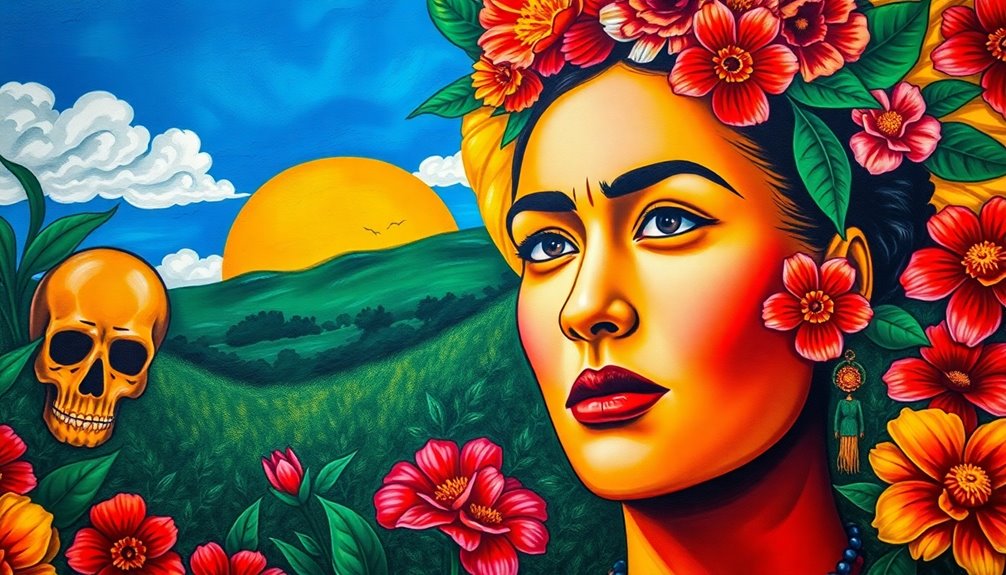
Frida Kahlo's bold color palette stands as a vibrant tribute to her Mexican heritage, celebrating the rich cultural identity of her homeland.
You'll notice how the bright hues in her paintings create a striking contrast between pain and joy, reflecting the complexity of human emotions.
Each color choice isn't just for aesthetics; it tells a story deeply rooted in her personal and cultural experiences.
Bold Color Palette
Kahlo's bold color palette bursts forth, immersing viewers in the vibrant essence of Mexican culture. Her use of vivid hues not only showcases her personal expression but also reflects the emotional landscape of her life. You'll notice how she intertwines themes of pain and joy, employing contrasting colors to emphasize the dualities that define her experiences. Each brushstroke serves as a reflection of her struggles and triumphs.
The vibrant colors in works like "The Little Deer" and "Fulang-Chang and I" embody her cultural roots, illustrating the depth of her identity. By incorporating traditional Mexican pigments and pre-Columbian techniques, Kahlo celebrates her heritage while highlighting symbolic elements that resonate with viewers.
Her ability to convey complex emotions through color is a hallmark of her artistry, inviting you to explore the layers of meaning in her work. Through her bold color palette, Kahlo transforms her pain into a visual narrative, offering you an intimate glimpse into her world.
This celebration of vibrant colors not only honors her cultural identity but also serves as a powerful reminder of the beauty that can emerge from suffering.
Mexican Heritage Reflection
When you look at Frida Kahlo's paintings, it's impossible to ignore how her vibrant colors reflect her deep Mexican heritage. Kahlo utilized bold hues to symbolize the essence of Mexico, infusing her art with a cultural identity that's unmistakably linked to her roots. She incorporated traditional Mexican pigments and pre-Columbian techniques, emphasizing her commitment to authenticity in every brushstroke.
Common motifs like marigolds and cacti in her work celebrate her heritage while evoking strong scents and imagery tied to Mexican traditions. These elements serve as powerful symbols, layering her personal narrative with rich cultural symbolism.
Kahlo's art often blends folklore with emotional depth, allowing you to feel the intensity of her experiences. The contrast of bright colors highlights the complexities of her emotional journey, showcasing themes of pain and joy in a way that resonates deeply.
Each painting invites you to explore the vibrant tapestry of her life and identity, where every hue and element carries a story. Through her work, Kahlo not only reflects her Mexican heritage but also creates a lasting dialogue about the power of cultural identity in art.
Contrast of Emotions
Vibrant colors leap off the canvas in Frida Kahlo's art, reflecting a rich tapestry of emotions that intertwine joy and pain. Her paintings are a vivid exploration of the contrast of emotions, where vibrant colors symbolize her cultural identity and the complexities of her experiences.
- Bright hues like reds and greens celebrate her Mexican heritage while representing her pain and suffering.
- In works such as "The Two Fridas," contrasting colors illustrate the duality of her identity, showcasing her emotional struggles.
- Floral motifs, including marigolds and cacti, intertwine beauty and pain, reinforcing her connection to cultural symbolism.
Frida's use of traditional Mexican pigments and pre-Columbian techniques enhances these symbolic representations, creating an emotional depth that resonates with viewers.
The duality of her identity becomes palpable through her art, where vibrant colors don't just exist for aesthetics; they serve as a powerful narrative of resilience. This interplay of joy and sorrow invites you to explore deeper into her psyche, uncovering the layers of her personal journey.
Frida Kahlo's work stands as a reflection of the profound relationship between cultural identity and emotional expression. Furthermore, her art exemplifies the significance of cultural intelligence (CQ) in understanding diverse experiences and enhancing emotional connections.
Mexican Culture and Political Commentary
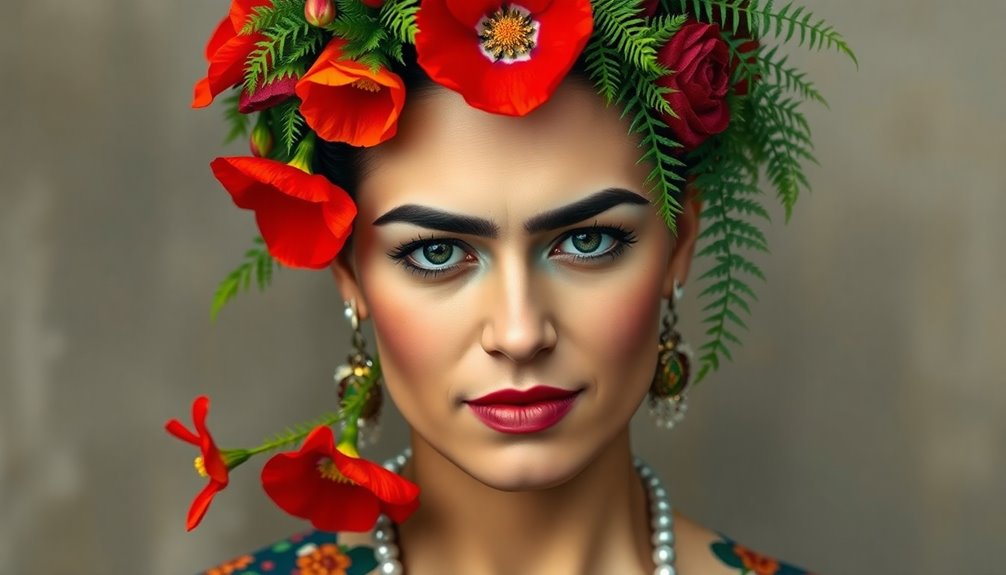
Frida Kahlo's art serves as a powerful lens through which you can explore Mexican culture and political commentary. Her work is rich with traditional symbols that celebrate her indigenous heritage and Mexican identity, like marigolds and cacti. By wearing the Tehuana dress, she connects herself to her roots while asserting the importance of female identity within Mexican culture.
Kahlo's involvement with the Mexican Communist Party infuses her art with sharp political commentary. She skillfully critiques societal norms, using symbolic imagery to address social issues and advocate for change.
In "The Two Fridas," you see her cultural duality displayed, reflecting the emotional conflict between her mixed heritage and the struggle for acceptance in a divided society.
Her piece "Tree of Hope" embodies themes of resilience, showcasing her unwavering spirit amid adversity. Through these artworks, Kahlo encourages you to reflect critically about the complexities of Mexican culture and the political landscape of her time.
She weaves a narrative that not only honors her identity but also challenges you to contemplate the broader implications of her message.
Feminist Perspective in Kahlo's Art
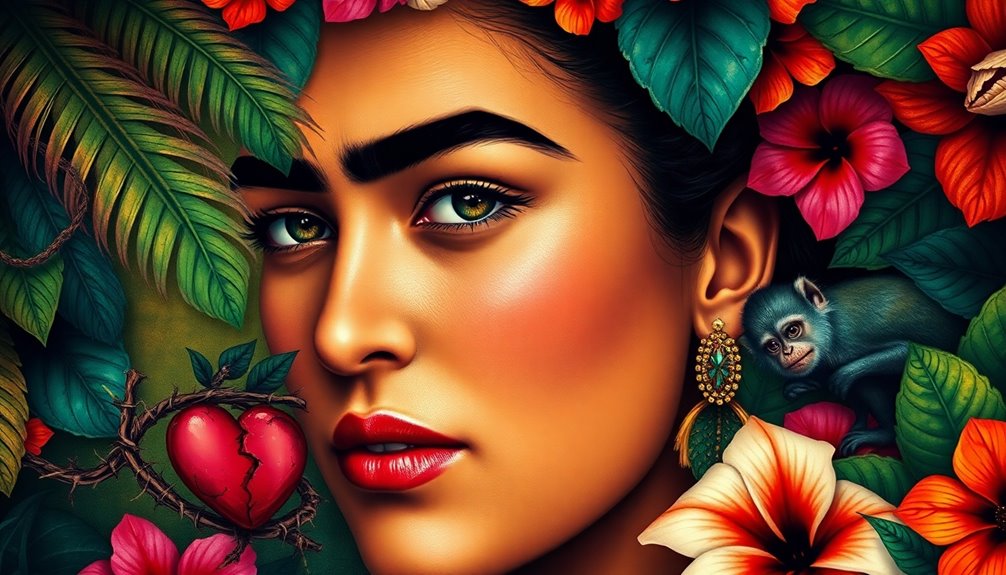
Kahlo's exploration of identity naturally extends into a feminist perspective, where her art actively challenges traditional gender norms. By weaving together themes of pain, motherhood, and emotional vulnerability, she critiques the patriarchal structures that shape women's lives. You see this clearly in her unique style, which combines personal experiences with broader societal issues.
- In "Self-Portrait with Cropped Hair," cutting her hair symbolizes defiance against societal expectations of femininity, asserting her personal agency.
- The use of animals, such as monkeys and hummingbirds, reflects complex aspects of femininity and sexuality, often paralleling her physical and emotional struggles.
- Kahlo's legacy as a feminist icon lies in her ability to depict personal suffering and resilience, inspiring future generations to embrace their identities.
Through her artistic expression, Kahlo invites you to engage with the realities of women's experiences, showcasing the intimate connection between her personal life and the larger feminist movement.
Her work not only celebrates female strength but also challenges you to confront the inequalities that persist in society today.
Symbolism in Notable Works
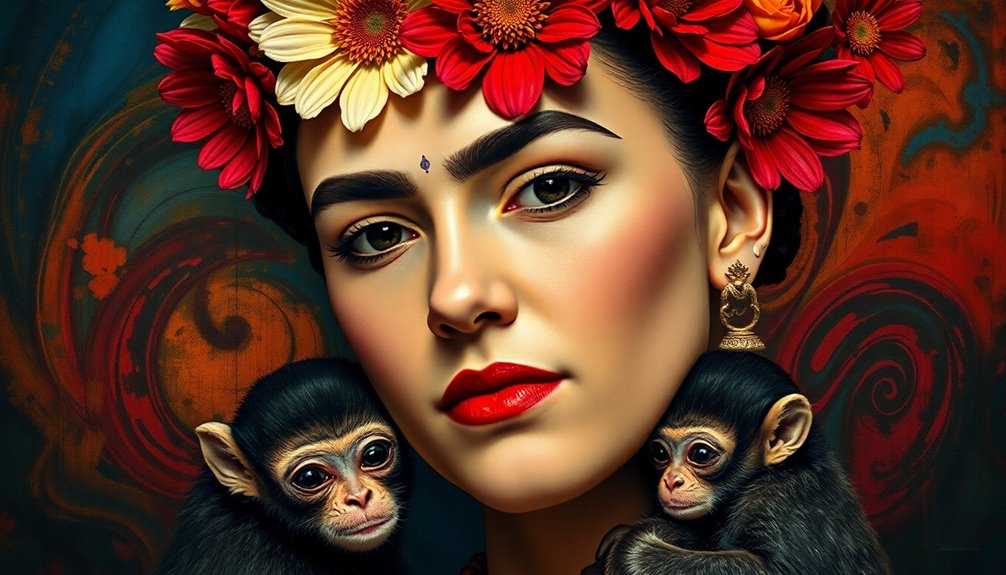
Often, symbolism plays an essential role in Frida Kahlo's notable works, allowing her to convey complex emotions and themes. Kahlo created paintings that often reflect her unique blend of physical suffering and emotional turmoil.
In "Self-Portrait with Thorn Necklace and Hummingbird," the thorn necklace symbolizes her endurance, while the hummingbird represents hope amid pain.
In "The Two Fridas," the contrasting identities display her emotional conflict following her divorce from Diego Rivera, highlighting the duality of her existence.
Similarly, "The Broken Column" captures her vulnerability, with her spine depicted as a broken column, emphasizing her physical and emotional pain.
Kahlo's "The Little Deer" shows her as a wounded deer, symbolizing injury and vulnerability, while also referencing themes of martyrdom and sacrifice.
Finally, in "Self-Portrait with Cropped Hair," the act of cutting her hair serves as a powerful rejection of traditional femininity and societal expectations, reflecting her emotional struggles during a challenging time.
Through these symbols, Kahlo's art expresses her innermost feelings, making her work deeply resonant and impactful.
Animals as Symbols in Art
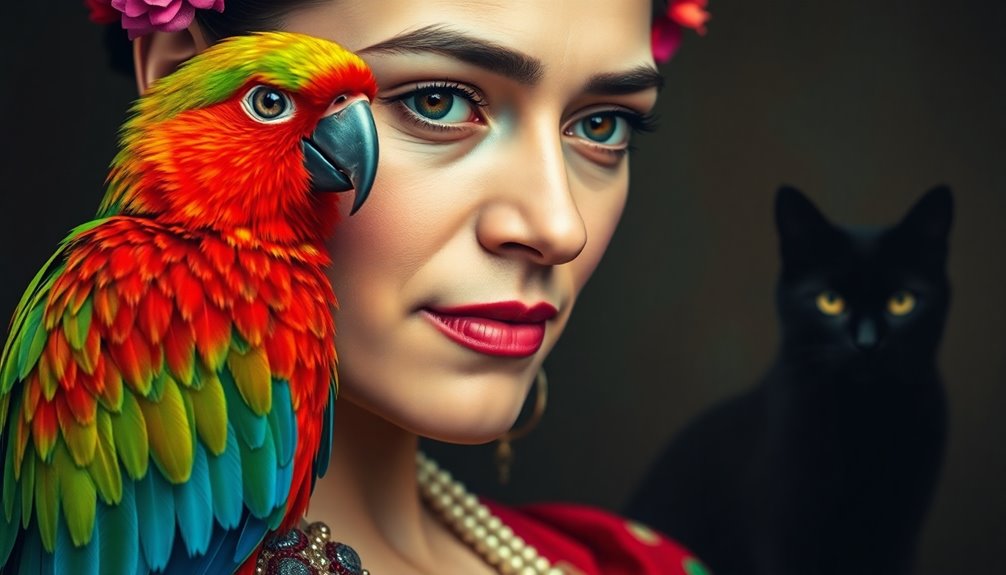
Utilizing animals as symbols in her artwork, Kahlo creates a rich tapestry of meaning that reflects her innermost feelings and experiences. Each animal represents a specific aspect of her identity and emotional connections, revealing deeper layers of her personal narrative.
- Monkeys: Often depicted in her paintings, monkeys symbolize lust and companionship, representing her complex relationship with desire and emotional intimacy.
- Hummingbirds and Cats: In "Self-Portrait with Thorn Necklace and Hummingbird," the hummingbird stands for hope and resilience, while the black cat symbolizes bad luck, illustrating the duality of her experiences.
- Butterflies: Frequently associated with resurrection and rebirth, butterflies reflect Kahlo's encounters with trauma and renewal, serving as a reminder of her strength through adversity.
Through these animals as symbols, Kahlo intertwines her struggles with cultural identity and personal trauma, creating a visual dialogue that resonates with viewers.
Each creature embodies her emotional landscape, allowing you to connect with her story on a profound level. Kahlo's symbolic use of animals invites you to explore not just her life, but also the universal themes of love, loss, and transformation.
Influence of Other Artists and Cultures
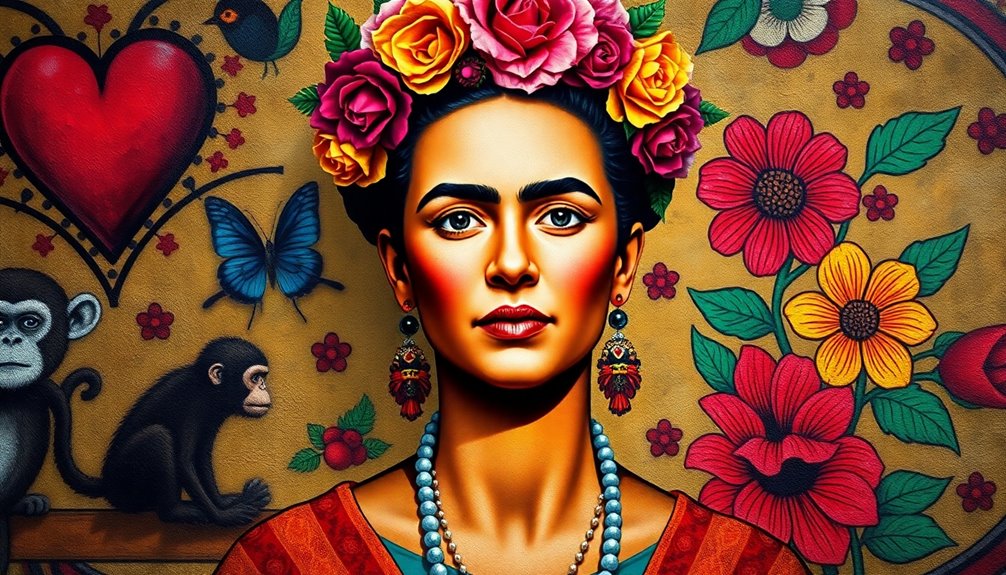
Frida Kahlo draws on a diverse tapestry of influences from other artists and cultures, enriching her work with layers of meaning. You can see this in her self-portraits, where she often combines elements of European art with her rich Mexican heritage.
For instance, her painting "The Wounded Deer" shows a nod to Andrea Mantegna's depiction of Saint Sebastian, reflecting vulnerability and suffering.
Kahlo's incorporation of Christian symbolism, like the thorn necklace in "Self-Portrait with Thorn Necklace and Hummingbird," deepens the emotional impact of her art, intertwining personal pain with religious narratives.
Additionally, she celebrates her cultural heritage through traditional Mexican clothing and motifs from indigenous mythology, such as marigolds and cacti, which resonate with her identity.
Frequently Asked Questions
Why Is Frida Kahlo a Symbol of Feminism?
Frida Kahlo's unapologetic exploration of identity, pain, and love makes her a powerful symbol of feminism.
You see her challenge traditional gender roles through vivid self-portraits that embrace her unique beauty and mixed heritage.
By confronting societal expectations, she advocates for women's independence and empowerment.
Her art reflects the complexities of female experiences, inspiring you and many others to embrace authenticity and fight against patriarchal norms.
Kahlo's legacy resonates deeply in feminist discourse.
What Do the Two Fridas Symbolize?
In "The Two Fridas," you see two contrasting figures, each representing different aspects of identity.
One Frida, adorned in traditional Mexican attire, embodies cultural roots, while the other, dressed in European fashion, reflects her ancestry.
They share a vein, symbolizing emotional connection and pain. Their exposed hearts illustrate vulnerability, while the blood signifies loss and turmoil.
This poignant representation captures the complexities of love, identity, and the scars that shape your existence.
What Does the Wounded Deer Symbolize?
In "The Wounded Deer," you see Frida Kahlo representing herself as a deer pierced by arrows, which symbolizes her deep physical and emotional pain.
The deer reflects vulnerability and suffering, echoing themes of endurance amidst adversity.
The surrounding dense forest represents her isolation and internal struggles.
You can't help but feel the empathy evoked by the vibrant colors and the deer's expressive eyes, inviting you to connect with her turmoil and experiences.
What Does the Butterfly Symbolize Frida Kahlo?
Imagine a world where pain transforms into beauty, where every wound brings forth a butterfly.
In Frida Kahlo's art, butterflies symbolize resurrection and transformation. They remind you that even after the darkest storms, renewal is possible.
These creatures dance delicately around her self-portraits, representing the fleeting nature of life and the hope that blooms from suffering.
Each butterfly whispers tales of freedom and connection to her soul, echoing resilience amid turmoil.
Conclusion
Frida Kahlo's art isn't just visually striking; it's a profound exploration of identity, pain, and culture. Did you know that over 50% of her self-portraits feature symbolic elements reflecting her experiences? This highlights how deeply intertwined her personal struggles were with her Mexican heritage and feminist ideals. By using symbolism, Kahlo invites you to connect with her story, making her work timeless and relatable. Her legacy encourages you to embrace your own complexities and emotions through art.

